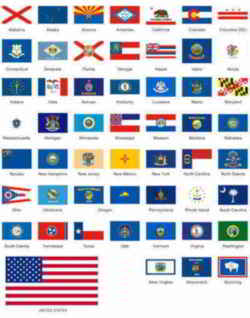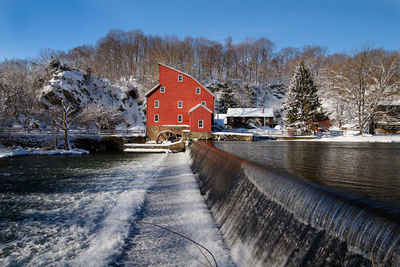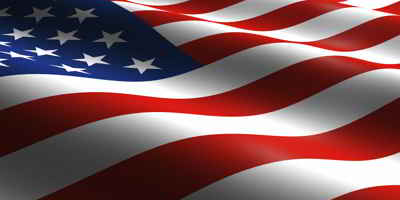New Jersey State
Flag
Adopted in 1896.
The New Jersey State flag displays the official State colors. The State seal is presented in Jersey blue on a buff background. The colors were chosen by General George Washington in 1779, after he was headquartered in New Jersey during the Revolutionary war. These were the military colors used by the New Jersey troops.
In 1896, New Jersey made it official and properly described the New Jersey State Flag in a joint resolution of the legislature (see below).
The State seal in the center of the flag contains a horse's head. A helmet showing that New Jersey governs itself and three plows on a shield referring to the State's agriculture tradition, giving it the nickname "Garden State". The two Goddesses represent the State motto, "Liberty and Prosperity". Liberty is on the left. She is holding a staff with a liberty cap on it, and the word liberty underneath her. The goddess on the right is Ceres, goddess of agriculture. She is holding a cornucopia with prosperity written below her.
The New Jersey State Flag
The State flag of New Jersey is buff colored. The buff color of this flag represents the coats of the uniforms that General George Washington and New Jersey troops wore during the Revolutionary War. The state coat of arms is emblazoned in the center. The shield has three plows with a horse's head above it. Two women represent the goddesses of Liberty and Agriculture. A ribbon at the bottom includes the year of independence in 1776 and reads: Liberty and Prosperity. The New Jersey state flag was formally adopted in 1896.
The following memorandum appears in the Minutes of the New Jersey General Assembly for March 11, 1896 on page 347:
"The minutes of the last meeting were read and approved. Mr. (Charles F.) Hopkins (of Morris County) offered the following memorandum, which was read: On March 23rd, 1779 during the war of the Revolution, the Continental Congress, by resolution authorized and directed the Commander-in-Chief to prescribe the uniform, both as to color and facings, for the regiments of the New Jersey Continental Line. In accordance with this resolution, General Washington, in General Orders dated Army Headquarters, New Windsor, New York, October 2nd, 1779, directed that the coats for such regiments should be dark blue, faced with buff. On February 28th, 1780, the Continental War Officers in Philadelphia directed that each of said regiments should have two flags, viz: one the United States flag and the other a State flag, the ground to be of the color of the facing. Thus the State flag of New Jersey became the beautiful and historic buff, as selected for it by the Father of His Country, and it was displayed in view of the combined French and American armies in the great culminating event of the War of the Revolution, the capitulation of a British army under Lieutenant General Earl Cornwallis at Yorktown. The same color has been prescribed for the state flag of New York, where a law requires it to be displayed with the United States flag over the capital when the legislature is in session. The inquiry arises, why did General Washington select the beautiful historic buff facings exclusively for the Continental lines of New York and New Jersey when such facings were only prescribed for his own uniform and that of other Continental general officers and their aides-de-camp? He evidently made the selection not only designedly, but for historic reasons. New York and New Jersey had originally been settled by the Dutch. Dark blue (Jersey blue) and buff were Holland or Netherlands insignia. The Governor as commander-in-chief represents the State of New Jersey, and should have a prescribed headquarters flag, different from that used by infantry, cavalry or artillery. In custom, every state Governor has one, but the propriety of an enactment on the subject is obvious. Mr. Hopkins, on leave, introduced Assembly Joint Resolution No. 2 to define the state flag. Under Chapter 170, P.L. 1965, the official colors of New Jersey for use on the state flag and for other purposes were established by statute as buff and Jersey blue.
In a 1965 law, the specific color shades of Jersey blue and buff were defined by the state. Using the Cable color system developed by The Color Association of the United States, Jersey blue was defined as Cable No. 70087; buff was defined as Cable No. 65015
New Jersey Assembly Joint Resolution No. 2 THE STATE FLAG
The New Jersey state flag is defined and described in Joint Resolution No.2 of 1896, which reads as follows:
Joint Resolution to Define the State Flag
1. BE IT RESOLVED by the Senate and General Assembly of the
State of New Jersey:
The State flag shall be of buff color, having in the
center thereof the arms of the State properly emblazoned
thereon.
2. The State flag shall be the headquarters flag for the
Governor as Commander-in-Chief, but shall not supersede
distinctive flags which are or may hereafter be prescribed
for different arms of military or naval service of this
State.
3. This act shall take effect immediately. Chapter 170, P.L. 1965 CHAPTER
170, LAWS OF N.J.
Approved September 30, 1965
New Jersey SENATE, NO. 159
Purpose of this Act the specifications, references and designations for the official colors
STATE OF NEW JERSEY
Introduced February 15, 1965
BY SENATOR FARLEY
AN ACT establishing the official colors of the State of New
Jersey.
BE IT ENACTED by the Senate and General Assembly of the State
of New Jersey:
The official colors of the State of New Jersey for use
on the state flag and for other purposes shall be buff and
Jersey blue.
For the purposes of this act the specifications,
references and designations for the official colors of the
State are as follows:
Jersey Blue (Cable No. 70087, royal blue. The Color
Association of the United States, Inc.)
Buff (Cable No. 65015, US Army buff. The Color
Association of the United States, Inc.)
New Jersey Flag Law
New Jersey Permanent Statutes, Title 52.
TITLE 52 STATE GOVERNMENT, DEPARTMENTS AND OFFICERS
52:3-1. State flag; color
The state flag shall be of buff color, having in the center thereof the arms of the state emblazoned thereon.
52:3-2. State flag to be headquarters flag
The state flag shall be the headquarters flag for the governor as commander in chief, but shall not supersede distinctive flags which are
or may be prescribed for different arms of military or naval service of this state.
52:3-3. Display of flag on state house
A suitable flag shall be hoisted and displayed on the state house flagstaff during the hours when the senate or house of assembly is in
session, and on such days as the governor is present at the state house for the transaction of state business in the discharge of his
official duty, and it shall be the duty of the custodian of the state house, or such person as shall be delegated to take care of such
building, to display such flag during the hours intervening between sunrise and sunset upon all national holidays.
52:3-4. Display of foreign flag unaccompanied by national flag prohibited; exception; violation misdemeanor
It shall be unlawful to display the flag or emblem of any foreign state or country either on public or private property within this state,
unless such foreign flag or emblem be accompanied by a national flag of the United States of America, of at least equal dimensions; but
whenever a foreigner becomes the guest of the United States, the state, or any city or municipality, upon the proclamation of the governor
or the mayor of any such city or municipality, the flag of the country of which such public guest shall be a citizen may be displayed upon
any state, county or municipal building without being accompanied by a national flag as above provided.
Any person violating this section shall be guilty of a misdemeanor, and punished by a fine not exceeding one hundred dollars, or
imprisonment in the county jail not exceeding sixty days, or both.
52:3-5. Preservation of historic flags
All historic battle and other flags of the State displayed in the State House shall be maintained and preserved by the State authority in
whose custody they are. Removal of historic battle flags for display elsewhere than in the State House may be authorized by the State
House Commission.
Amended by L.1961, c. 16, p. 92, s. 1.
52:3-6. Display of state flag
The State flag may be displayed on all occasions and in such manner as it shall be appropriate and lawful to display the flag of the
United States.
L.1938, c. 86, p. 205, s. 1.
52:3-7. Historic flags; repair and preservation
The Adjutant-General is hereby authorized and directed to provide for the repair and preservation of all historic flags of the State of
New Jersey.
L.1938, c. 129, p. 281, s. 1.
52:3-8. American Night on National Flag Day
The Governor be and he is hereby authorized to name, designate and hereafter cause to be known the period between sundown and midnight of
National Flag Day as "American Night."
L.1938, p. 1006, Joint Res. No. 7, s. 1.
52:3-9. Findings, declarations
The Legislature finds and declares that:
a. Over 2,400 Americans, including 64 from the State of New Jersey, who served in the United States armed forces during the war in
Indochina are still listed as prisoners of war or missing in action.
b. There is significant evidence that many of these missing American servicemen are still alive and being held against their will in
Indochina.
c. This nation is deeply indebted to its servicemen of all wars and conflicts for their courage and sacrifice and should demonstrate its
special commitment to the missing men of all wars and conflicts and their families by obtaining the release of those still held prisoner
and the fullest possible accounting from the responsible governments of Americans listed as missing.
d. The P.0.W.-M.I.A. flag is an appropriate symbol of the plight of these missing Americans which serves to remind the public of the
commitment this nation must have to determining the fate of its servicemen.
e. It is appropriate, therefore, that the P.0.W.-M.I.A. flag should be displayed at public buildings throughout this State in order to
increase public awareness of the P.0.W.-M.I.A. issue and to gain public support for the efforts of the United States government to resolve
this matter.
P.L. 1988, c. 16, s. 1
52:3-10. P.O.W.-M.I.A. flag display
The P.0.W.-M.I.A. flag, which depicts a prisoner's profile against the background of a P.0.W. camp watchtower, shall be displayed at
public buildings in the State of New Jersey during normal business hours.
As used in this section, "public buildings" means the principal municipal building in each municipality, the principal county building in
each county seat and the State House in Trenton.
P.L. 1988, c. 16, s. 2.
52:3-11. Flag at half-staff
The Governor shall, upon receiving timely notification and verification of the death of a New Jersey citizen who has been awarded the
Congressional Medal of Honor by an act of the Congress of the United States, direct that the State flag at all public buildings throughout
the State be flown at half-staff for a period of one week following the death of such a citizen.
P.L. 1988, c. 43, s. 1.
52:3-12 State House flags flown at half-staff; death in line of duty for police, firemen, paramedics, EMTs.
1. a. The Governor, upon timely notification and verification of the death of a federal, State or local law enforcement officer or
firefighter who either works in New Jersey or is a citizen of New Jersey and who died in the line of duty, shall direct that the flag of
the United States and the State flag be flown at half-staff for one week at the State House. The flags shall be flown upon an existing
flagstaff or flagstaffs or, at the option of the Governor, a flagstaff or flagstaffs erected at an appropriate site, after consultation
with organizations representing law enforcement officers and firefighters on the location and design of the flagstaff or flagstaffs.
The flags flown in honor of the deceased law enforcement officer or firefighter shall be presented to the family of that officer or
firefighter.
b.The Governor, upon timely notification and verification of the death of a member of a duly incorporated first aid and emergency or
volunteer ambulance or rescue squad or association rendering services in a county or municipality of this State or a duly certified mobile
intensive care paramedic or emergency medical technician who either works in New Jersey or is a citizen of New Jersey and who died in the
line of duty while rendering first aid, ambulance, rescue or emergency medical service, shall direct that the flag of the United States
and the State flag be flown at half-staff for one week at the State House. The flags shall be flown upon an existing flagstaff or
flagstaffs or, at the option of the Governor, a flagstaff or flagstaffs erected at an appropriate site, after consultation with
organizations representing first aid, ambulance, rescue or emergency medical service providers on the location and design of the flagstaff
or flagstaffs.
The flags flown in honor of the deceased member, paramedic or technician shall be presented to the family of that member, paramedic or
technician
L.1998,c.16,s.1.

The Flags of the US.







